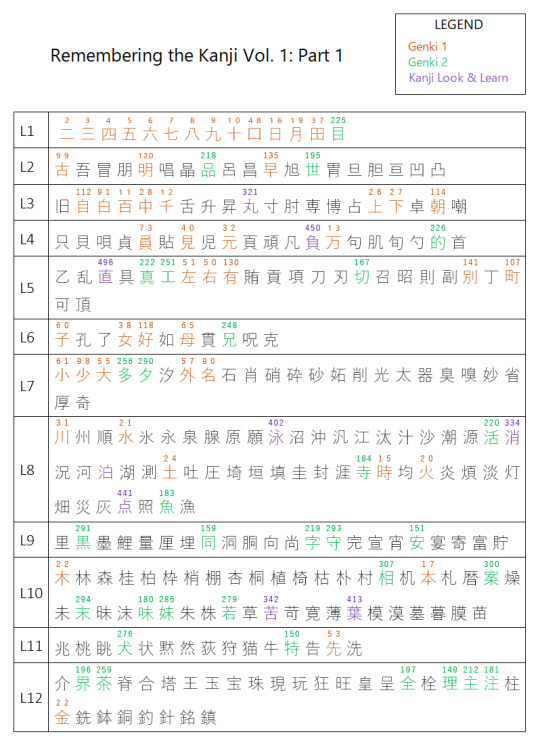My blog about learning Japanese and Living in Sasebo!!
Don't wanna be here? Send us removal request.
Photo

みんな、こんにちは!元気ですか。
最近、仕事は助かれているけど、漢字チャレンジを続けるのが頑張る!げんき1」のレッスン10をまだ始めなかった。週末に始めたい…頑張る!
とにかく、漢字チャレンジが好き!難しくてけど、楽しいも!
–
What I’ve been doing to learn how to recognize kanji:
1. Pick apart the kanji and break it down into its components (also called ‘primitives’ in the RTK method, which are fully indexed on this blog). Reference Japandict and KanjiAlive for radicals to better understand how the kanji is put together. (Why this is easier than trying to memorize all the radicals)
2. Come up with a story that links the kanji’s keyword with its components. If I can’t come up with my own story, check Kanji Koohii and/or Heisig.
3. If the keyword seems odd or hard to remember, copy/paste the kanji into jisho.org to see if there’s a better meaning. Cross-reference this meaning with Heisig’s keywords (using this list) to avoid redundancy. (This article talks about renaming keywords a bit more.)
4. Edit the card in Anki during steps 2 and 3 as needed.
5. Do reviews in Anki.
–
This article incorporates learning how to write the kanji during the above process:
Read through the story and write the kanji down, listing the primitives next to it.
Say the kanji character’s story to yourself aloud while you write it and create a mental image of the story.
Go into Anki and do your review for the day. As you review each kanji, write it out on paper. If you get it wrong, re-read the character’s story, write the kanji out again 2–3 times, and say the story aloud as you write.
I have yet to try this, but I want to give it a shot. Recently, I’ve been growing more and more convinced of the utility of handwriting kanji to help learn them, differentiate them from each other, and make them stick in my long-term memory. (Check out this article!)
–
Additional resources:
https://www.youtube.com/watch?v=sspUdoV9Il0 - A hilarious video by Chris (Abroad in Japan) about the RTK method
https://hochanh.github.io/rtk/rtk1-v6/index.html - Lists all 2200 kanji in volume 1 of RTK (the newest 6th edition) with links containing animated stroke order and stories from both RTK and Kanji Koohi
https://rtkwiki.koohii.com/wiki/Walkthrough - Tips from people who got through the RTK method successfully, organized by lesson
https://www.japandict.com/kanji - Wonderful online dictionary with different search functions, including by radical (what Heisig calls ‘primitives’)
https://kanjialive.com/214-traditional-kanji-radicals/ - Full list of radicals
253 notes
·
View notes
Text
I CAN INTORDUCE MYSELF NOW YAYYYY!!
こんにちは。僕の名前はホプです。はじめまして!
It’s not a lot, but I feel really good about it.
6 notes
·
View notes
Text
_は_です。
わたし I
あなた you
かれ he
かのじょ she
わたしたち. We
あなたたち. You (pl.)
かれら. They (m.)
かのじょら. They (f.)
がくせい student
せんせい teacher
アメリカ America
じん -nationality
にほん Japan
0 notes
Note
hi, im interested in learning more about brujeria,, do you have any good sources or materials you could recommend?? thank you so much!
Hello there anon! I don’t really answer questions like this anymore because I’m not a very active practitioner and I kinda keep all of that private. I hope you find answers somewhere, though! I wish you luck on your journey.
26 notes
·
View notes
Text
I want to say this my first day in Japan omg

Filed under : Japanese expressions I need to start slipping into everyday conversation
2K notes
·
View notes
Text
A lot of that katakana characters look so much alike— ケ and ク look so much a like.. I got scared haha
Easily Differentiate similar Katakana
Shi & N , Tsu & So are made using similar pattern! Use this mnemonics to remember them~

The stroke difference. One is Horizontal while the other is vertical!

Differentiate Ku, Ta and Nu

Happy learning! 。゚✶ฺ.ヽ(*´∀`*)ノ.✶゚ฺ。
…………………………………………
Links:
• CrunchyNihongo - Easy to Learn Japanese Lessons Site • Get our easy Japan lessons on your facebook timeline
3K notes
·
View notes
Text
I just finished learning hiragana.
I feel a little burn out, and I really don’t want to start learning katakana... but when I go through and try to read things, I see it’s used a lot soooo here we go I guess 😅
0 notes
Photo

Weather & Seasons | In Japan Hey guys, today we’re gonna talk about the seasons and weather in Japanese! It’s common to talk about the weather in any language when making small talk, so let’s check out what you might say in Japanese! Winter・冬・ふゆ In Japan Winter is from December to February! In Northern and Central Japan you’re likely to experience snowfall during Winter. Spring・春・はる In Japan Spring is from March to May! The Cherry Blossoms bloom during Spring. Summer・夏・なつ In Japan Summer is from June to August! There’s a month long rainy period during Summer in Japan. Besides the rainy season it’s generally very hot and humid. Autumn・秋・あき In Japan Autumn is from September to November! Autumn in Japan is very cool and breezy. Vocabulary Seasons・季節・きせつ Autumn・秋・あき Dry Season・乾季・かんき Four Seasons・四季・しき Rainy Season・雨期・うき Spring・春・はる Summer・夏・なつ Winter・冬・ふゆ Weather・天気・てんき Cloud・雲・くも Cloudy・曇り・くもり Cool・涼しい・��ずしい Cold・寒い・さむい Flood・洪水・こうずい Fog・霧・きり
Evening Fog・夕霧・ゆうぎり
Morning Fog・朝霧・あさぎり
Hail・雹・ひょう Heavy Rain・大雨・おおあめ Heavy Snow・大雪・おおゆき Hot・暑い・あつい Humidity・湿度・しつど Hurricane・ハリケーン Rain・雨・あめ Snow・雪・ゆき Sun・太陽・たいよう Sunny・晴れ・はれ Temperature・温度・おんど Thunder・雷・かみなり Tsunami・津波・つなみ Typhoon・台風・たいふう Warm・暖かい・あたたかい Weather Forecast・天気予報・てんきよほう Wind・風・かぜ You can add the word 「とても」, which means ‘very’, before the phrases to emphasise the weather. For example, to say that it’s very cold 「とても寒い」or very hot「とても暑い」. Expressions: e.g. 風が強いです。 It’s windy. 今日はいい天気です。 The weather today is nice. ひどい天気ですね。 Terrible weather, isn’t it?I 外は雨が降っています。 It’s raining outside. ここ最近はとても暑いですね。 It’s been very hot lately, hasn’t it?
7K notes
·
View notes
Text
Learn Japanese with Animal Crossing - Lesson 1 (もちもの)

持ち物 - もちもの

もつ - to possess, to hold, to carry, to take (持つ)
もの - thing, object (物)
もちもの - one’s property, things you carry (持ち物)

How to form a noun from a verb with もの
1. put the verb in ます form (もちます)
2.cut down the ます end (もちます)
3.attach もの (もちもの)
4. In the end we will get a noun (もちもの).
Unfortunately it doesn’t apply for all verbs but I will list some of them which works with もの.
たべもの - food (食べ物)
のみもの - beverage (飲み物)
かいもの - purchased goods (買い物)

かぐ - furniture (家具)
もっている家具 - furniture you have, furniture you carry (持っている家具)

ている grammar
1.put the verb in て form (もって)
2.attach いる (もっている)
Be doing something, is/am/are doing
For example: 私はミルクを飲んでいます - I am drinking milk.

いふく - clothes (衣服)
あつめる - to collect (集める)
そざい - raw materials (素材)
クラフト - craft
ざいりょう - ingredients, material (材料)
どうぐ - tool, implement (道具)
タネ - seed (種)
しょくぶつ - plant, vegetation (植物)
めずらしい - unusual, rare (珍しい)
いく, いきる - to live, to exist (生く, 生きる)
いきもの - living thing, animal (生き物)

I hope you enjoyed the first Lesson ^^! It’s a little bit short, because I don’t really have time these days, I apologise for that. If you liked the lesson or you want a sequel just reblog or like the post ^^! If you find any mistake please write me a message and I will correct it urgently. Thank you ^^! - Dzseni
2K notes
·
View notes
Text
Apps I use for Japanese





I started learning last week. All of these except the last one is really helping me learn how to read 🥴
3 notes
·
View notes




